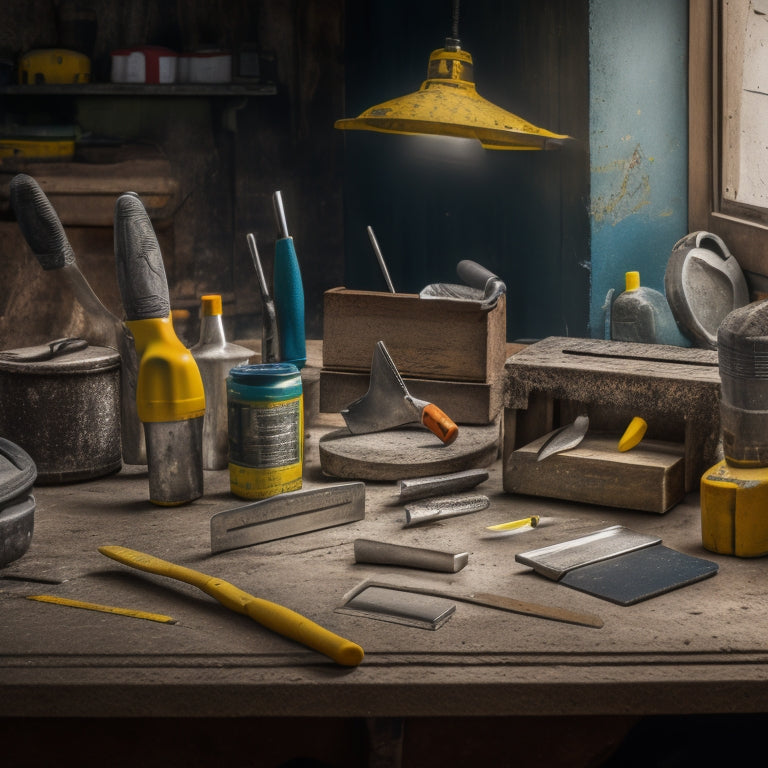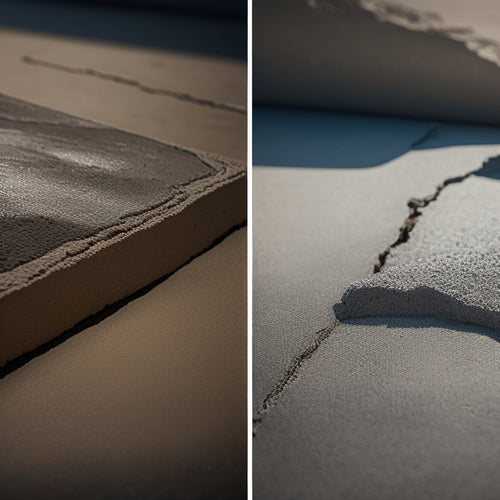
Measuring Tools You Need for Concrete Repair
Share
When tackling concrete repair, you'll need a range of measuring tools to guarantee accuracy and precision. A tape measure, level, and marking tools are essential for diagnosing and preparing surfaces, while specialized tools like digital calipers, surface roughness gauges, and crack width gauges provide critical data for cinder block sealing and crack measurement. Laser levels, digital calipers, and straight edges further enhance precision, and measuring tapes and angle finders help with distance and angle measurements. With these tools, you'll be well-equipped to tackle complex concrete repairs - and by exploring each tool's capabilities, you'll uncover even more ways to refine your techniques and achieve superior results.
Key Takeaways
• Accurate measurements are crucial in concrete repair, requiring a range of measuring tools, including tape measures, levels, and marking tools.
• Specialized tools like digital calipers, surface roughness gauges, and porosity meters are necessary for specific tasks, such as cinder block sealing and crack measurement.
• Crack width gauges, surface profilometers, and laser levels provide precise measurements of cracks, surface roughness, and layout patterns.
• Digital calipers and straight edges ensure accurate measurements of internal and external dimensions, and verify evenness of substrates.
• Angle finders and measuring tapes are essential for measuring angles, distances, and layouts, enabling precise cuts and alignments in concrete repair.
Measuring and Marking Tools Needed
You'll require a set of measuring and marking tools to accurately diagnose and prepare the concrete surface for repair, guaranteeing precise measurements and markings that guide your subsequent repair work.
These tools are essential for identifying cracks, voids, and other defects that need attention. A 25-foot tape measure, for instance, allows you to take precise measurements of the concrete slab, while a level guarantees the surface is even and plumb.
A marking gauge or chalk line helps you create accurate markings, enabling you to transfer measurements onto the concrete surface. To achieve measurement accuracy, it's vital to use high-quality tools that provide precise readings.
Marking techniques, such as using a carbide-tipped marker or a soapstone, are also critical for creating clear, visible marks that won't fade or smudge.
Cinder Block Sealing Measuring Essentials
When sealing cinder blocks, precise measurements are vital to secure a watertight seal, and that's where specialized measuring tools come in.
You'll need to accurately assess the block's dimensions, surface irregularities, and joint widths to guarantee a proper seal. A digital caliper or micrometer will allow you to take precise measurements of the block's width, length, and height, making sure for a snug fit for your sealant.
For sealing large areas or joints, you'll need to measure the surface roughness and porosity of the cinder block. A surface roughness gauge will help you determine the best sealant thickness and type. Additionally, a porosity meter will enable you to assess the block's water absorption rate, vital for selecting the right sealing technique.
To maximize cinder block durability, it's important to use the correct sealing techniques. A precise measurement of the joint width and surface irregularities will guide your choice of sealant and application method.
Crack Width and Depth Gauges
As you inspect a crack in the concrete, you'll need to measure its width accurately to determine the best course of repair.
You'll also want to assess the depth of the crack to guarantee you're addressing the full extent of the damage.
Measuring Crack Width
Measuring crack width accurately is essential in determining the severity of concrete damage and selecting the appropriate repair method.
You'll need to conduct a thorough crack analysis to identify the extent of the damage and develop effective repair strategies.
To do this, you'll rely on crack width gauges, which provide precise measurements of the crack's width. These gauges typically consist of a series of calibrated markings or a digital display that indicates the width of the crack.
Here's what you can expect when using a crack width gauge:
-
Precise measurements: Crack width gauges provide accurate readings, usually to the nearest 0.01 mm, ensuring you have a clear understanding of the crack's severity.
-
Easy to use: These gauges are designed for simplicity, allowing you to quickly take measurements and move on to the next step in your repair process.
-
Durable construction: Crack width gauges are built to withstand the demands of a construction site, ensuring they remain functional even in harsh environments.
Assessing Depth Accurately
You'll need to combine crack width measurements with depth assessments to fully understand the extent of concrete damage, which is where crack width and depth gauges come into play. These gauges are essential for accurate depth assessment techniques, providing precise measurements to inform your repair strategy.
To get an accurate measurement, you'll need to insert the gauge's probe into the crack at a 90-degree angle. The gauge will then provide a reading of the crack's depth. Here's a breakdown of the types of crack width and depth gauges and their capabilities:
| Gauge Type | Measurement Range | Accuracy |
|---|---|---|
| Digital Depth Gauge | 0-10 mm | ± 0.1 mm |
| Mechanical Depth Gauge | 0-5 mm | ± 0.2 mm |
| Ultrasonic Depth Gauge | 0-50 mm | ± 0.5 mm |
| Laser Depth Gauge | 0-100 mm | ± 0.1 mm |
| Acoustic Depth Gauge | 0-20 mm | ± 0.3 mm |
Detecting Hidden Damage
By combining crack width and depth measurements, concrete repair specialists can uncover hidden damage that might otherwise go undetected, allowing for a more detailed understanding of the concrete's overall condition.
This all-encompassing approach helps identify potential issues that could compromise the structural integrity of the concrete.
When evaluating cracks, consider the following scenarios:
-
A hairline crack on the surface may be hiding a deeper, more extensive network of cracks beneath, which could be allowing hidden moisture to seep in and cause further damage.
-
A crack that appears narrow at the surface may be wider at the base, indicating a more severe problem that requires immediate attention.
-
A crack that seems shallow may be a sign of more extensive damage deeper in the concrete, which could lead to catastrophic failure if left unchecked.
Surface Profilometers for Roughness
Surface profilometers accurately quantify concrete surface roughness, enabling you to determine the ideal repair strategy. By conducting surface texture analysis, you can gather detailed information about the surface's topography, which is essential for selecting the correct repair materials and techniques. These devices measure the roughness profile evaluation, providing you with a precise understanding of the surface's peaks, valleys, and overall texture.
When evaluating concrete surfaces, you'll often encounter varying degrees of roughness, from minor imperfections to severe damage. Surface profilometers help you quantify these variations, guaranteeing that you address the underlying issues effectively.
For instance, if the surface exhibits high roughness values, you may need to apply a specialized primer or perform additional surface preparation to ascertain a strong bond between the old and new concrete.
Laser Levels for Straight Lines
Laser levels project precise, self-leveling lines and planes, allowing you to accurately establish straight references for concrete repair tasks. These devices are crucial for ensuring that your repairs are level, plumb, and square. With a laser level, you can create a reference plane that guides your work, reducing errors and increasing efficiency.
Here are some benefits of using laser levels in concrete repair:
-
Increased accuracy: Laser levels provide a precise reference point, eliminating the need for manual measurements and reducing the risk of human error.
-
Improved efficiency: With a laser level, you can work faster and more confidently, as you'll have a clear visual guide for your repairs.
-
Enhanced precision: Laser levels enable you to create complex layouts and patterns with ease, making them ideal for intricate concrete repair projects.
When selecting a laser level, you'll encounter different types, including dot lasers, line lasers, and rotary lasers. Each type has its own unique benefits and applications, so it's important to choose the right one for your specific needs.
Digital Calipers for Accuracy
Measuring concrete repair materials and substrates with precision requires accurate readings, which is where digital calipers come into play, providing you with exact measurements down to the hundredth of a millimeter. These precision measurement tools are a game-changer in concrete repair, offering numerous digital caliper benefits that enhance your work quality and efficiency.
| Digital Caliper Benefits | Precision Measurement Techniques |
|---|---|
| High Accuracy | Measure internal and external dimensions with ±0.01mm accuracy |
| Easy Data Transfer | Transfer measurements to your device or software via Bluetooth or USB |
| Versatility | Measure depth, step, and diameter with a single tool |
With digital calipers, you can capture precise measurements quickly and easily, ensuring that your concrete repairs meet the highest standards. By leveraging these precision measurement techniques, you'll reduce errors, improve workflow, and deliver exceptional results. By incorporating digital calipers into your toolkit, you'll take your concrete repair skills to the next level, achieving mastery in your craft.
Straight Edges for Flat Surfaces
Ensuring flat surfaces in concrete repair requires you to verify the evenness of substrates, and that's where straight edges come into play, providing a reliable means to detect even the slightest deviations from flatness.
These tools are essential for surface alignment techniques, as they help you identify any irregularities that may affect the final product.
When working with straight edges, you'll encounter various types, including:
-
Aluminum straight edges: Lightweight and corrosion-resistant, ideal for large surfaces
-
Steel straight edges: Heavy-duty and durable, suitable for heavy construction projects
-
Fiberglass straight edges: Non-conductive and resistant to warping, perfect for working with electrical components
Measuring Tapes for Distance
You'll rely on measuring tapes to accurately determine distances between anchor points, beam edges, or other vital reference markers in concrete repair projects.
When it comes to measuring tapes, you have several options to choose from, including fiberglass, steel, and cloth tapes. Each type has its own unique benefits and drawbacks, so it's important to select the right one for your specific project needs. For instance, fiberglass tapes are ideal for indoor use, while steel tapes are more suitable for outdoor applications.
To achieve accurate distance measurements, it's important to employ proper measurement techniques. Start by extending the tape to the desired length, making sure it's taut and straight. Then, take readings at the desired points, using the tape's markings to determine the distance.
You can also use the tape's built-in features, such as a fractional readout or a digital display, to simplify the measurement process. By mastering the use of measuring tapes and distance measurement techniques, you'll be able to achieve precise results and guarantee the success of your concrete repair project.
Angle Finders for Precise Cuts
When making precise cuts in concrete, getting the angle right is essential, and that's where angle finders come in. They provide a reliable way to determine and transfer exact angles from one surface to another.
These versatile tools are perfect for a range of angle finder applications, from intricate tile work to large-scale construction projects.
With an angle finder, you can:
-
Measure angles between two surfaces, ensuring accurate cuts and joints.
-
Transfer angles from one surface to another, eliminating errors and guesswork.
-
Verify existing angles, checking if they match the original design specifications.
Frequently Asked Questions
Can I Use a Single Tool for Both Measuring and Marking?
When tackling a project, you wonder if you can rely on a single tool for both measuring and marking. The answer is yes, you can.
Multi-purpose tools are designed to streamline your workflow, and some excel at marking techniques. With the right tool, you'll save time and reduce errors.
Look for instruments that combine precision measurement with accurate marking capabilities, allowing you to efficiently transfer measurements to your material.
Are Digital Calipers Suitable for Measuring Curved Surfaces?
When measuring curved surfaces, you'll want a tool that guarantees accuracy.
Digital calipers are a great choice, offering versatility in measuring complex shapes. Their precision and adaptability make them ideal for capturing precise dimensions on curved surfaces.
With a digital caliper, you'll achieve accurate readings, even on irregular shapes. This level of precision is essential when working with curved surfaces, where small deviations can have significant consequences.
Do I Need to Calibrate My Laser Level Regularly?
You'll want to prioritize laser level maintenance to guarantee accuracy in your concrete repair projects.
When it comes to calibration frequency, you should check your laser level's manual for specific guidelines. Typically, you'll need to calibrate it every 3-6 months, depending on usage and environmental factors.
Failure to do so can result in deviations of up to 1-2 mm, which can be critical in concrete repair.
Stay on top of calibration to secure precise measurements and avoid costly mistakes.
Can I Use a Measuring Tape to Measure Irregular Shapes?
Get ready to channel your inner Leonardo da Vinci and tackle those irregular shapes!
When it comes to measuring irregular shapes, you're probably wondering if a trusty measuring tape will do the trick. The short answer is yes, but with caveats.
While a tape can provide decent accuracy, it may not be the most reliable option for precise irregular measurements. You'll need to carefully navigate the tape around curves and corners to guarantee accuracy.
Are Surface Profilometers Necessary for Small Concrete Repairs?
When tackling small concrete repairs, you might wonder if surface profilometers are necessary.
The answer lies in the complexity of the surface texture. If you're dealing with a simple, smooth surface, a profilometer might be overkill.
However, if the surface is rough or has varying textures, a profilometer guarantees repair consistency by providing precise measurements of the surface's profile.
This is essential for achieving a seamless repair that blends with the surrounding area.
Conclusion
Now that you've got the essential measuring tools for concrete repair, you're ready to tackle any project.
Remember, accuracy is key to a successful repair.
Did you know that according to the American Concrete Institute, the average concrete structure has a lifespan of 50-60 years?
With the right tools and techniques, you can extend that lifespan and guarantee a strong, durable repair that will last for years to come.
Related Posts
-

Must-Have Tools for Laying Concrete Tiles
When laying concrete tiles, you'll need a range of essential tools to get the job done right. Start with subfloor pre...
-

Why You Need Affordable Concrete Wall Construction Tools
You need affordable concrete wall construction tools to guarantee a profitable project, as the cost of equipment can ...
-

What Tools Ensure Strong Concrete Adhesion at Home
You'll need the right tools to guarantee strong concrete adhesion at home. For surface preparation, use concrete surf...


